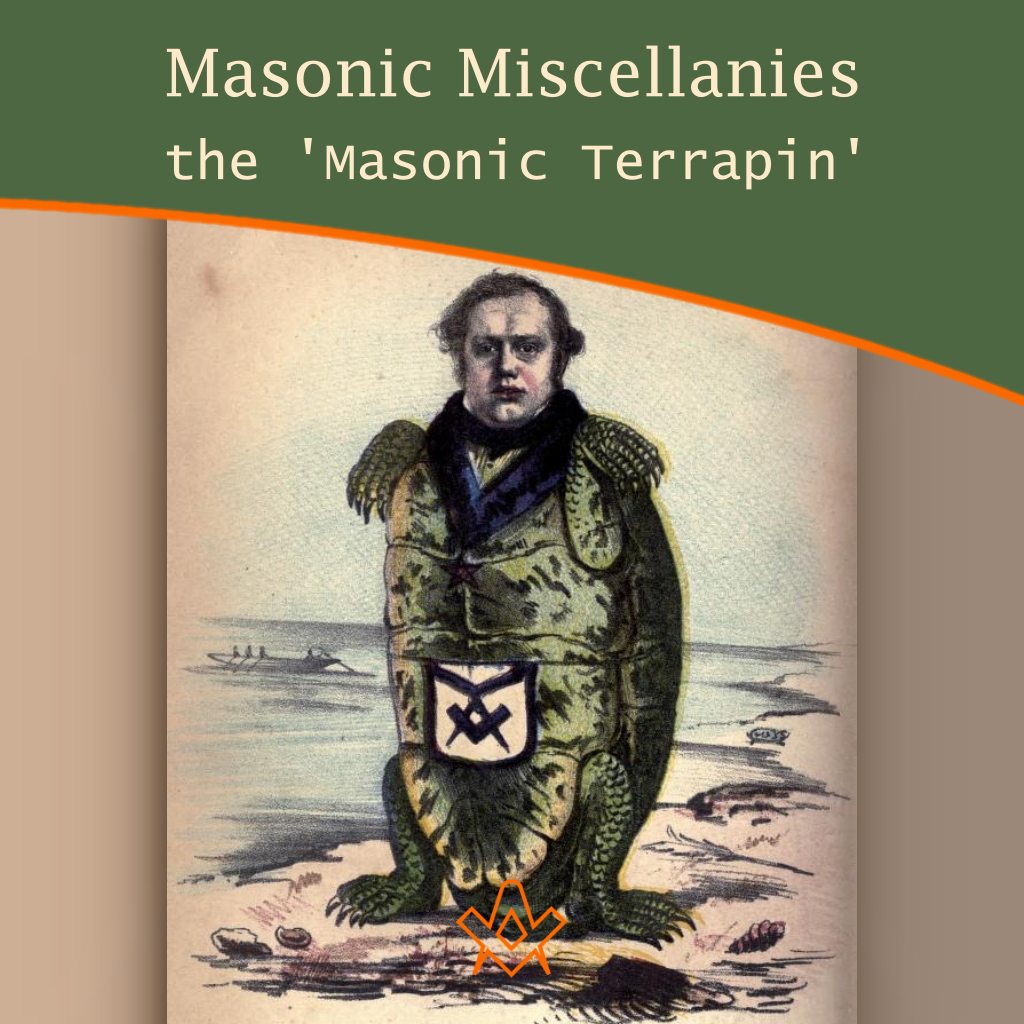As is my wont, I always try to find obscure and intriguing articles for our Masonic Miscellanies slot – this month I have found something so utterly surreal that it may be the most miscellaneous Masonic miscellany ever!
– Philippa (Editor)
As usual, whilst researching something vaguely related (in this case an artist called Max Rosenthal), I discovered within a text entitled The comic natural history of the human race (H. L. (Henry Louis Stephens), a bizarre image entitled ‘The Masonic Terrapin’.
The book is a satirical offering from 1851, with eccentric and very surreal descriptions of 39 contemporary figures, mostly Philadelphians, accompanied by a colour lithograph portrait of each, showing his or her face on the body of a bird or animal.
The caricatures were a tongue-in-cheek poke at the ‘great and the good’ of the era.
The descriptive text associated with each cartoon is by various contributors and are equally odd in their subject matter and prose.

I have no idea which prominent Mason was chosen to depict the ‘Masonic Terrapin’ but I can’t imagine the cartoon, or the description (written by ‘Richard Vaux’) was positively received!
If anyone can work out which Freemason from 1851 the caricature resembles/fits, do let us know!
One of the end pages appears to include a partial list of possible ‘victims’.

The books’ artist was Henry Louis Stephens, and the lithographs produced and signed by ‘L. Rosenthal, Phila.’, a lithographic company run by two brothers Louis and Max Rosenthal.
The book was published by Samuel Robinson of Philadelphia, Pennsylvania
So, without further ado, I offer you – THE MASONIC TERRAPIN
The Preface
“It is common-place to talk of this being the age of wonders; we shall not therefore insist upon it in this our Preface; but will only hint our entire conformity to such prevalent idea, and inform the public at once that we are about to give some illustrations of it.
In various aspects of their ever-changing, phantasmago-rical, kaleideiscopical or transmigratorial characters, we have some fancies, which we shall show in such a strong light as no dissolving view or master-piece of fireworks ever begun to approach.
Transmigration is held to be very marvellous, even abstractly as a doctrine only ; and we associate with it ideas of idolatrous ram-worshiping Hindoos, and other far-off out- siders, but we have discovered it to commonly happen close at home.
We shall show, amongst many other important things, some of the shapes into which men try, and rather successfully too, to transform themselves…”
THE MASONIC TERRAPIN (OBSTETRIX AUCTORUM)

The Chapter in full:
When the artist presented for our inspection, the drawing of the Masonic Terrapin, we were sorely oppressed with “a confluence of ideas on the brain.”
It was almost an ideal-apoplexy : not however of that sort which is produced by eating terrapins. We lost all consciousness.
Phantoms of Morganised turtles — Masonic suppers — free blows — champagne and cigars — songs and stories : — wit and whiskey — wine and watchmen — dyspepsia and diarrhoeticks passed before our vision, with funereal slowness and solemnity.
It was long before we returned to a sense of actual vitality. Gazing on the picture, dreaming of the vision, the first impression that took the form of thought was to audibly inquire, if all these things belonged to the “Family Robinson” — an indignant No from our publisher, startled us into our propriety.
Then it was we discovered the great resemblance between a free mason and a free terrapin. It is in their shut-up-iveness.
Ask a Mason his secret, touch him with an interrogatory, and he shuts-up, mum as a mummy. Touch a free terrapin as he is going quietly into his lodge on the sea-shore, to ask him when he will be ready for supper — and he shuts-up just like the Mason.
The ancient York Mason, and the York cove oyster, and the York bay terrapin, must have some astounding secrets among themselves; when any do come out, won’t the people gulp them down, secrets and shell-fish — ^which will go down the best, depends very much on how they are ” cooked up.”
A secret on a chafing-dish, is a novelty — although the Masons do talk a great deal about their secrets on the “gridiron.”
It is about as easy for one to be “done brown,” on either utensil.
There is a marked resemblance between the turtle and the Mason : as we have shown — ^but we think the verisimilitude is liable to be yet further extended.
There are as we know, mock turtles, snapping turtles, green turtles, and land turtles : so with the Masons — but the green Masons predominate over the snappers, and the mock Masons are scarce.
The only aqueous specimen we ever heard of, was the one that mysteriously found its way into Niagara : this must have been a female specimen — of rather doubtful reputation — we never knew her consort, and she had a large family.
Out of respect to so delicate a relation in life, her offspring always called her aunty-Mason.
We have thrown, all the ‘light of Masonry,’ or rather terrapinic Masonry, in our power ; if more is desired by the reader, we refer him to R. W. P. G. M. Chandler, who any night in the wick, will light up, show the moulds and the dips of ancient Greece, and then sit down over a Masonic terrapin, and other fixings, with a degree of satisfaction only known to the mysteries of the Order.
There is something very fat, jovial, good-natured, and convivial in a terrapin.
Who has not decided a bet over terrapin for 6? — who has not been of the party, feasted on terrapins and champagne ? — who has not been invited to join the social ‘circle’ in a ‘box,’ over terrapin and punch, where the night has glided away, till the small hours of the morning have crawled on the board?
Poor, defenceless, uncomplaining, heart-broken, secret- keeping terrapin.
Food for publishers, painters, parsons, parasites, publicans, patriots, politicians, poets.
Let us for a moment imagine three or four quiet, solemn, hungry parsons, after long fasting, with good digestion and a ” special collection,” orderly assembled, on a bleak, dreary, windy, December night, over ” terrapins for half a dozen,” a ” little good old spirits,” and cigars for their several affections of the bronchial organs : a picture of self-denial, victorious over worldly lust!
Oh, if McClees & Germon, celebrated in their art, would only use their renowned skill in daguerreotyping these “shepherds,” over this repast! Poor terrapin!
Unite as a subscriber to a dinner to a ” distinguished statesman;” take a seat at the table; listen to the speech of the chairman ; the patriotic toasts ; the great speech of the Hon. Washington Jefferson Jackson Smallpotatoes; and cast your eye on the poor terrapin — still it keeps its own secret : mason-like.
It never lets out a word or sign of complaint or anguish. It serves as the basis of all the satisfaction of these gatherings. It performs an important part, in political or pious feasts.
That the student may not be in doubt, we have drawn the likeness of one of these singular quadrupeds in full life.
It “stands erect,” full of fat and fun. In one eye you see the mischievous twinkle of a “Billy Vidkins,” in the other, the quiet drollery of a “John Donkey” — a combination of character, which once germinated in the phiz of a ‘printer’s devil,’ but which is now subdued into that intelligent serio-comic expression which so admirably belongs to ‘our publisher.’
Extraordinary terrapin! True to its character, it furnishes food for the fun-loving reader to-day ; to-morrow solemnizes itself into a condition to refresh the pious Christian who delights in religious literature ; the next day, cooked up into that flavor which gives a gout to a ‘Dutch almanac,’ and ever and anon is hashed up into all kinds of ragouts, from a ‘paper book’ to a ‘pamphlet.’
Good terrapin! Never complaining, always fat, ever jolly, universally secret, yet proffering ‘proof upon proof of the characteristics we have delineated.
The unlearned reader may inquire, if our specimen is a ‘heifer’ or a ‘cow,’ as by these terms terrapins are known to the epicure.
What a question to be suggested after all we have already said! A cow? Oh, Sam, who would have thought for a moment, you could be mistaken for any ‘udder’ kind than you are! You are no cow; you worship at no such titulary shrine.
Benevolent as our artist has truthfully drawn you, you are the parent of no such common-veal, as, with the “lowing herd, winds slowly o’er the lea.”
Meek, gentle,and kind as you are, no cow-ard blood is to be found under your shell. No, poor terrapin, you are no cow, whatever else you may be.
Judging from the eggs, which are regarded as so delicate a morceau in the cooked terrapin, one would fain believe you were a fowl — yet you are “no chicken” — however much you may, as our publisher, look after our brood, as the result of ‘Hen’s’ eggs.
You may be a heifer. But after taking a look at the drawing, we opine, that he who would doubt as to your proper position in this or any other Natural History might expect at your hands, what in France is called, a ” bull-verse-ment,” such a shaking, as in all after time could leave no doubt on the subject.
But so long as those ‘re-gal-ia’ are about, you will keep your secret on the subject; and we wont further put you “to press, “or have you bound ‘in calf,’ to answer.
You carry on your back a coat of ‘mail,’ at all events ; and if the public, in testimony of your efforts on our behalf, will only ‘shell-out,’ so that you may gain the ‘shell-ings,’ and save yourself from being one of Pharoah’s “lean kind,” you can stand well the cream of this joke, and not be under the necessity of committing cannibal-istic suicide, in eating yourself.
Poor terrapin! well, you have been cooked up in a new dish this time.
Some men say, “Save us from our friends!” but you can cry out! “Save me from a cuisine !” [don’t mistake the word for cousin] as thus being ‘ roasted’ is worse than “a stew.”
Roasted terrapin is an Epicurean novelty. And you don’t like it? Well, we have full faith in your Masonic teachings, that you will keep this as a secret, and never let the world know the current of your thoughts on the subject.
Fare-well, friend terrapin, and if in our remarks we have been the least personal — if we have trod on your toes — if we have hurt your feelings — if we have taken you by the “collar” — or pulled too hard at your “apron”-string — if we have put your temper to the “proof” — if we have said a word, that, unlike yourself, could be, mistaken — we will go to Guy’s, or Prosser’s, or ‘Jenny’s,’ or some other place, and settle this difference, by showing the difference between a Masonic terrapin and a terrapinized Mason.
Well, reader, who ever you may be, we have endeavored to en-lighten, instruct, and amuse you, on the subject of a Masonic terrapin in particular, or, more properly speaking, a particular Masonic terrapin.
Fully to understand all we wish the types to express, you must familiarize yourself with the process of practical printing.
Go for example into a large and celebrated printing establishment — take King & Baird’s — ask for the “head devil” of the concern, request him to inform you in what manner printing on types, or publishing, is connected with a Masonic terrapin.
The question is worth the asking, for he will answer it promptly, by introducing to you the publisher of Stephens’ Natural History; then, if you can properly realize the exact impression that ought at once to force itself on your mind, you will invite the editor, author, and publisher, and the printer that “set-up” this copy, to go round to “Rockwell’s,” and enjoy with you a good old-fashioned terrapin supper.
Well, let’s go. Just a snug party — Let’s see : Editor 1, publisher 2, reader 3, author 4, printer 5 ; yes, that’s right, come on! Sam! terrapins for V.
About the creators:
The Illustrator – Henry Louis Stephens

Self-portrait of the author Henry L. Stephens, as a caricature ‘The Hen That Hatched This Egg (Henry L. Stephens): Title Page, The Comic Natural History of the Human Race (1851)
Henry Louis Stephens (February 11, 1824 – December 13, 1882) was an American illustrator and editorial cartoonist.
Henry L. Stephens was born in Philadelphia in 1824. Around 1859, he went to New York under an engagement with Frank Leslie. After a year, he transferred his services to Harper & Brothers.
Stephens was a prolific artist and accomplished a great amount of work for book and magazine illustration.
Stephens was well known as a caricaturist, excelling especially in the humorous delineation of animals, and drew cartoons and sketches for;
The Cyclopedia of Wit and Humor (1858), a book edited by William Evans Burton,
Vanity Fair (1859–63),
Mrs. Grundy (1869),
Punchline (1870), and other periodicals.
He contributed artwork to Mark Twain’s comic memoir, Roughing It and the novel The Gilded Age: A Tale of Today by Mark Twain and Charles Dudley Warner.
He illustrated some children’s books, including Aesop’s Fables, Death of Cock Robin, and The House that Jack Built; he wrote and illustrated The Goblin Snob (c.1855), a satirical poem, as well as The Comic Natural History of the Human Race (1851).
He painted in watercolors, but rarely exhibited his works. Stephens died in Bayonne, New Jersey in 1882.
Source: Wikipedia
The Lithographer – Max Rosenthal

Max Rosenthal, self-portrait, 1903.
Max Rosenthal was born on November 23, 1833 in Turek, Kingdom of Poland.
He studied in Berlin under Professor Carl Harnisch and in 1847 he went to Paris, where he studied lithography, drawing, and painting with Martin Thurwanger, with whom he came to Philadelphia in 1849, to work under contract with Duval & Company.
After finishing his studies at the Pennsylvania Academy of Fine Arts in 1951, he became a partner with his brother Louis N. Rosenthal in his lithographic company known as ‘Rosenthals’.
This is most likely where he worked on the lithographs for Henry Stephens’ ‘The Comic Natural History of the Human Race’ (1951).
Rosenthal made the chromolithographic plates for what is believed to be the first fully illustrated book by this process in the United States, “Wild Scenes and Wild Hunters.”
In 1854 he drew and lithographed an interior view of the old Masonic temple in Philadelphia, the plate being 22 by 25 inches, the largest chromolithograph that had been made in the country up to that time.
He developed the first facsimile of water colors reproduced using the lithographic process in 1858.
He also invented a process of decorating glass using sand blasting in 1872.

Interior of the old Masonic Temple (demolished) of Philadelphia, drawn and chromolithographed by Max Rosenthal (1854) – Grand Lodge room of the new Masonic Hall, Chestnut Street Philadelphia.
He designed and executed the illustrations for various works, and during the Civil War followed the Army of the Potomac, and drew every camp, up to the Battle of Gettysburg. He made illustrations for the U.S. Military Commission.
These drawings he reproduced at the time. Up to 1884 he did miscellaneous works, including about 200 lithographs of distinguished Americans.
After 1884 he turned his attention to etching, and executed over 150 portraits of eminent Americans and British officers, together with numerous large plates.
He is the father of artist Albert Rosenthal. Max died on August 8, 1918 in Philadelphia, Pennsylvania.
Source: Wikipedia
Further reading:
About Max Rosenthal: digital.librarycompany.org
The Comic Natural History of the Human Race – full text with images: archive.org
Article by: Philippa Lee. Editor

Philippa Lee (writes as Philippa Faulks) is the author of eight books, an editor and researcher.
Philippa was initiated into the Honourable Fraternity of Ancient Freemasons (HFAF) in 2014.
Her specialism is ancient Egypt, Freemasonry, comparative religions and social history. She has several books in progress on the subject of ancient and modern Egypt. Selection of Books Online at Amazon
Recent Articles: Masonic Miscellanies
 Masonic Miscellanies - The Amulet of the Ladder Explore the cosmic significance of the Ladder in ancient Egyptian mythology through Wallis Budge's "Egyptian Magic." Discover how this profound symbol bridges the mortal and divine, encapsulating the Egyptians' fervent afterlife aspirations with a blend of myth, magic, and material culture. Dive into the celestial ascent of Osiris and mortal souls. |
 Masonic Miscellanies - Adulterine Gilds Guilds, the associations that shaped medieval European society, were more than just organizations of artisans and merchants. They played a vital role in the economic and social development of towns and cities. This exploration delves into the intriguing concept of adulterine gilds and their interconnectedness with guilds, offering insight into the significance of legal authorization and recognition in medieval Europe. |
 Masonic Miscellanies - Masonic Orb Discover the fascinating world of Masonic ball watch fobs, intricately crafted with tiny pyramids that form a cross when opened. These decorative accessories were all the rage in the late 1800s and early 1900s, and they still hold a certain allure today. Explore the different varieties and symbols found on these unique pieces that carry deep Masonic meaning. |
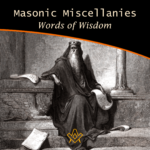 Masonic Miscellanies – Words of Wisdom Uncover timeless wisdom from King Solomon to Albert Pike in our latest Masonic Miscellanies, a treasure trove of insights for Masons. Journey through the ages and glean inspiring sayings, reflecting on their profound influence on Masonic principles. An enriching read for the enlightened. |
 Masonic Miscellanies - Symbolism of the Right Hand Unlock the enigmatic realm of Freemasonry as we delve into its age-old symbols, rituals, and philosophies. This thought-provoking exploration, drawn from Mackey's Revised Encyclopedia of Freemasonry, focuses on the iconic 'right hand' symbol - its rich history, universality, and profound significance. |
 Masonic Miscellanies - Order of the Secret Monitor Unveil the mystery of Freemasonry with 'The Order of the Secret Monitor'. Discover this lesser-known appendant order, its unique rituals, and the profound teachings it offers. Explore the bonds of friendship and brotherhood it fosters, all wrapped in an intriguing cloak of mystery. Your journey into the depths of Masonic wisdom begins here. |
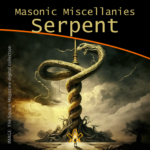 Masonic Miscellanies - The Symbol of the Serpent As a symbol, the serpent obtained a prominent place in all the ancient initiations and religions. |
 Masonic Miscellanies - The Four Veils in Royal Arch Masonry What are the four veils in Royal Arch Masonry? And what is the 'Ceremony of Passing the Veils'? Although common throughout Scotland, Ireland and the United States, it is mostly unknown in England, presently only worked in the Province of Bristol. ( and by dispensation ) |
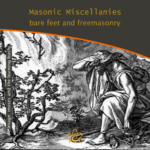 Masonic Miscellanies - Bare feet and Freemasonry A candidate for initiation into a Masonic Lodge often finds the requirements which he/she must fulfil somewhat odd. The mode of preparation often remains a puzzle, since the ritualistic explanation is not offered in full. Why are we 'slipshod' or "bare-footed" in Masonic Ritual? |
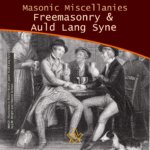 Masonic Miscellanies – Freemasonry and Auld Lang Syne Millions of people throughout the world will sing Auld Lang Syne to see out the Old Year. Few will know all the words, fewer still know what they mean, or that there is a link to Freemasonry. |
 Masonic Miscellanies - The Mosaic Pavement - why mosaic, why pavement? We are all familiar with the black and white chequered flooring of the Masonic lodge but where did it originate? There are a few theories… |
 Masonic Miscellanies – Masonic Master's Carpets Have you got a magic "Masonic Master's Carpet" in your lodge? I say 'magic' with my tongue firmly in my cheek because (as far as I know) these fabulous works of art don't bestow any mystical powers but can bestow some educational ones! However, considering their possible value today, they may magic up some interest (or funds). |
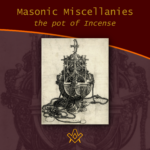 Masonic Miscellanies – The Pot of Incense Just when the pot of incense became an emblem of the third section of the Sublime Degree can not be stated with certainty. It is, apparently, an American invention or addition. But what does it symbolise? |
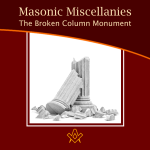 Masonic Miscellanies - The Broken Column Monument The story of the broken column was first illustrated by Amos Doolittle in the "True Masonic Chart" by Jeremy Cross, published in 1819. |
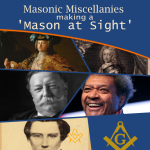 Masonic Miscellanies - Making a 'Mason at Sight' What does it mean to make a 'Mason at sight', and who was made one? |
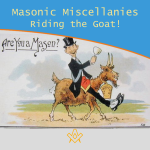 Masonic Miscellanies - Riding the Goat! Many Freemasons will have come across the phrase 'riding the goat', and will no doubt have been the butt of a joke about it (sorry, I couldn't resist!) But what does it mean and where did the phrase come from? |
 Masonic Miscellanies - What are the 'three dots'? Three dots or points in an upright triangular shape ∴ is most commonly known as the 'therefore' sign – so why is it used in Freemasonry? |
 Masonic Miscellanies - Keep Within Compass This month we discover a series of allegorical prints warning us to "Keep within Compass and you shall be sure, to avoid many troubles which others endure." |
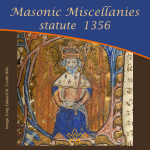 Masonic Miscellanies - statute 1356 Further to the reference in the article – The Builders - 6 - Free-Masons 'a statute was enacted against the Free-masons in 1356' – Regulations for masons who are hewers, on the one hand, and the light masons and setters on the other. |
 Masonic Miscellanies - An Anti-Masonic 'Apron'? The Anti-Masonic 'Apron' was created during the 1832 Presidential election in USA. It was not Ani-masonic. And it was not an apron. Read on to find out what and why it was created. |
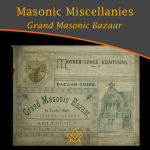 Masonic Miscellanies - Grand Masonic Bazaar (1895) Grand Masonic Bazaar (1895); to raise funds to clear the debt incurred by “Mother Kilwinning” in rebuilding their Lodge. |
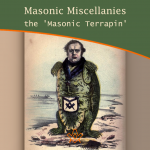 Masonic Miscellanies - the 'Masonic Terrapin' A satirical book from 1851 includes a bizarre caricature of a 'Masonic Terrapin' - all I can say is 'read on'… |
 Masonic Miscellanies - Masonic Bookplates You probably know what a bookplate is for, but did you know that the earliest known book mark/label dates from the reign of Amenhotep III in Egypt around 1391−1353 BCE?! |
 Masonic Miscellanies - Freemasonry & Bees Freemasonry & Bees - what's the buzz? The bee was among the Egyptians the symbol of an obedient people, because, says Horapollo, of all insects, the bee alone had a king. |
 Masonic Miscellanies - The mystery of the Tattooed Freemason In 1894, the body of a drowned man was found in the Bay of San Francisco - what they discovered was amazing. |
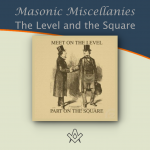 Masonic Miscellanies - The Level and the Square (A Poem) The Level and the Square (A Poem) - "We meet upon the Level, and we part upon the Square – |
 Masonic Miscellanies - The Mystic Tie What is the 'Mystic Tie'? Clue: it's not an item of neckwear! |
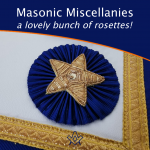 Masonic Miscellanies - A lovely bunch of rosettes! Where did the origin of the use of rosettes on Masonic aprons come from ? |
 Masonic Miscellanies - The Lodge of Sorrow The Lodge of Sorrow - Extracted General Ahiman Rezon, by Daniel Sickles, [1868] |
 Masonic Miscellanies - Memento Mori Memento Mori - a Masonic reminder to make your mark on the world |
 Masonic Miscellanies - A closer look at the Level and the Plumb-rule A closer look at the Level and the Plumb-rule |
 Masonic Miscellanies - The Symbolism of the Gloves The Symbolism of the Gloves and why Freemasons wear white gloves |
 Masonic Miscellanies - Will the real James Anderson please stand up? Will the real James Anderson please stand up? |
 Masonic Miscellanies - The Legend of the Third Degree The most important and significant of the legendary symbols of Freemasonry is, undoubtedly, that which relates to the fate of Hiram Abif. |
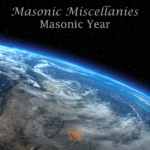 Masonic Miscellanies - Masonic Calendar Why do Freemasons use different 'years' to our regular calendar? |
 Masonic Miscellanies - What is a 'Lewis'? The English word 'Lewis' is a term belonging to operative Masonry, and signifies an iron cramp, which is inserted in a cavity prepared for the purpose in a large stone. |
 Masonic Miscellanies - From J.S.M. Ward Ever wondered why masons had to be 'free' or why we have a Tyler? |
masonic knowledge
to be a better citizen of the world
share the square with two brothers

click image to open email app on mobile device
Tubal Cain
Masonic Aprons NFT
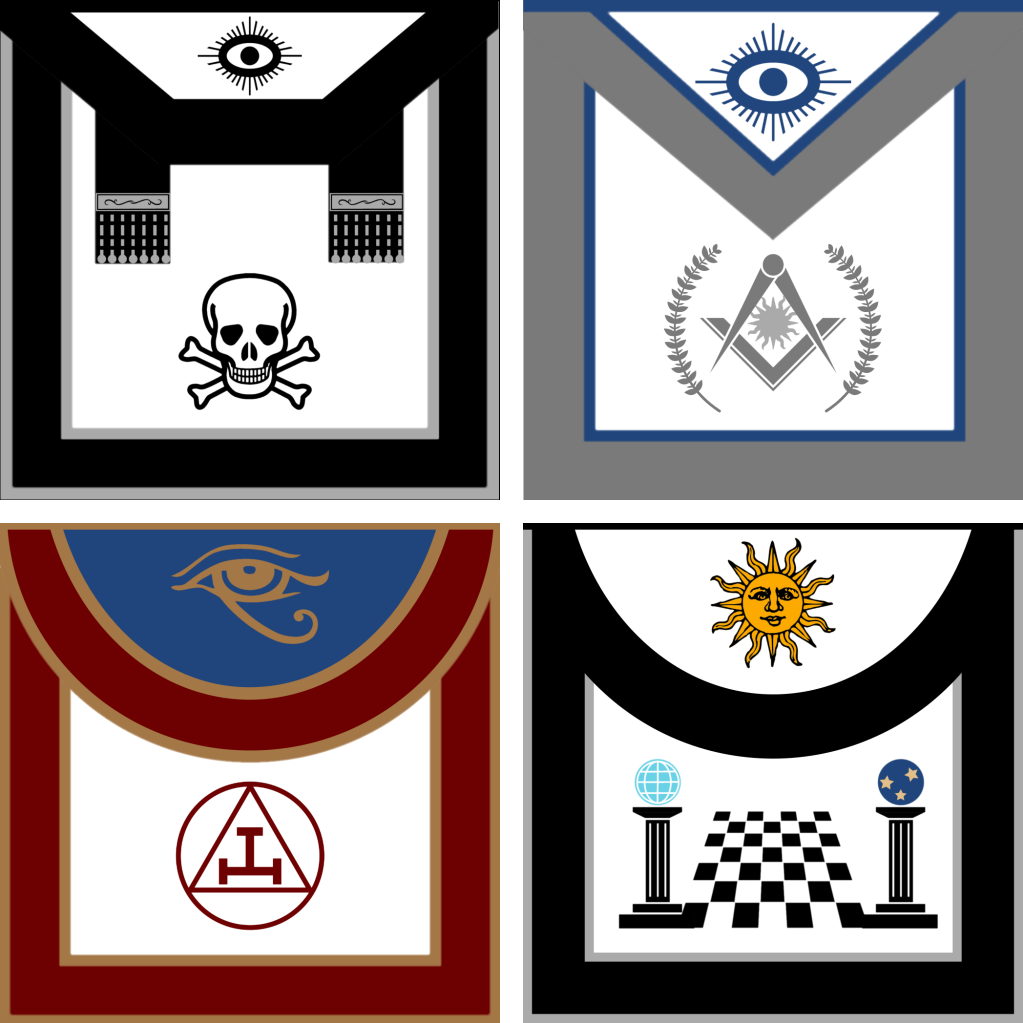



Each Tubal Cain Masonic Apron NFT JPEG includes a full size masonic apron and worldwide shipping
